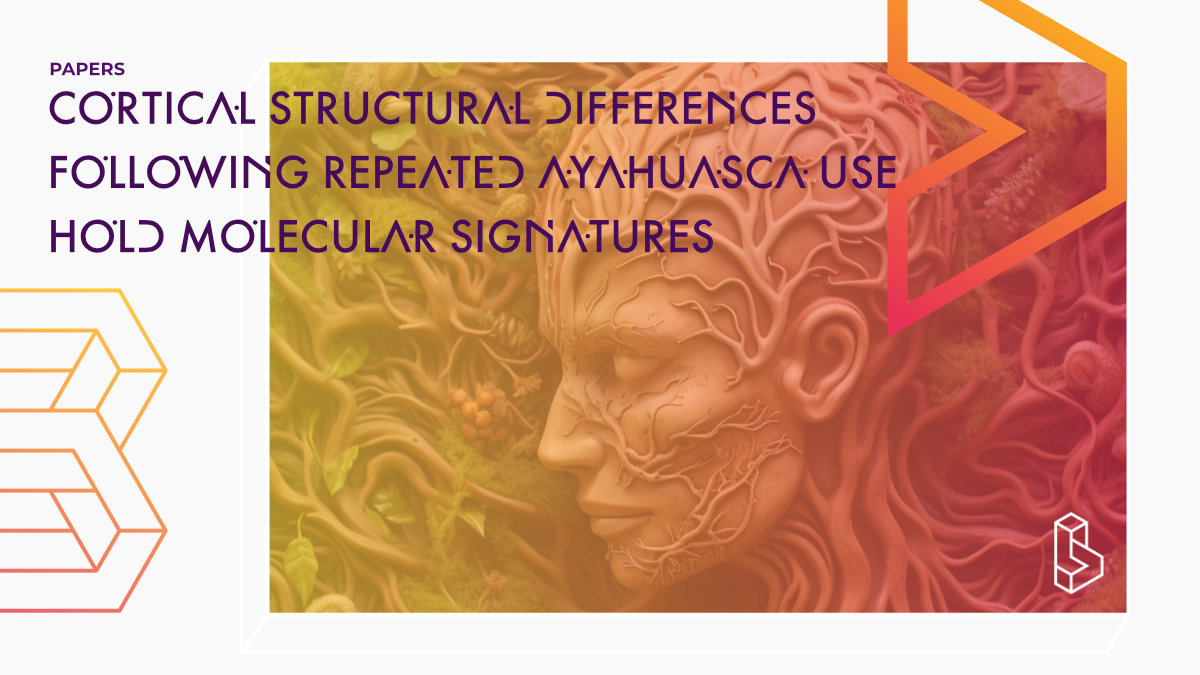This neuroimaging study (n=24 ayahuasca users from Santo Daime & case-matched controls) examined the relationship between cortical gene expression markers and brain morphometric changes following repeated ayahuasca use. It found that repeated ayahuasca usage was associated with spatially distributed cortical structural differentiation in sensorimotor areas and de-differentiation in transmodal areas, correlated with dysregulation of 5-HT2A gene expression and genes encoding target receptors. The study suggests preliminary evidence that molecular mechanisms of psychedelic action may influence large-scale brain organization, potentially accounting for behavioural differences in experienced psychedelic users.
Abstract of Cortical structural differences following repeated ayahuasca use hold molecular signatures
“Introduction Serotonergic psychedelics such as ayahuasca are reported to promote both structural and functional neural plasticity via partial 5-HT2A agonism. However, little is known about how these molecular mechanisms may extend to repeated psychedelic administration in humans, let alone neuroanatomy. While early evidence suggests localised changes to cortical thickness in long-term ayahuasca users, it is unknown how such findings may be reflected by large-scale anatomical brain networks comprising cytoarchitecturally complex regions.
Methods Here, we examined the relationship between cortical gene expression markers of psychedelic action and brain morphometric change following repeated ayahuasca usage, using high-field 7 Tesla neuroimaging data derived from 24 members of an ayahuasca-using church (Santo Daime) and case-matched controls.
Results Using a morphometric similarity network (MSN) analysis, repeated ayahuasca use was associated with a spatially distributed cortical patterning of both structural differentiation in sensorimotor areas and de-differentiation in transmodal areas. Cortical MSN remodelling was found to be spatially correlated with dysregulation of 5-HT2A gene expression as well as a broader set of genes encoding target receptors pertinent to ayahuasca’s effects. Furthermore, these associations were similarly interrelated with altered gene expression of specific transcriptional factors and immediate early genes previously identified in preclinical assays as relevant to psychedelic-induced neuroplasticity.
Conclusion Taken together, these findings provide preliminary evidence that the molecular mechanisms of psychedelic action may scale up to a macroscale level of brain organisation in vivo. Closer attention to the role of cortical transcriptomics in structural-functional coupling may help account for the behavioural differences observed in experienced psychedelic users.”
Authors: Pablo Mallaroni, Natasha L. Mason, Lilian Kloft, Johannes T. Reckweg, Kim van Oorsouw & Johannes G. Ramaekers
Summary of Cortical structural differences following repeated ayahuasca use hold molecular signatures
Introduction
Psychedelic compounds such as psilocybin, LSD and DMT have demonstrated significant utility for the treatment of neuropsychiatric disorders, including depression, anxiety, and substance-use disorders.
Current data strongly suggest that activation of the serotonergic 5-HT2A receptor mediates the acute hallucinogenic effects of psychedelics, but also potentiates neuroplastic adaptations proposed to underlie persisting symptom improvements. These changes span from the promotion of immediate early genes to more downstream evidence of augmented synaptogenesis, neurogenesis and dendritogenesis.
Find this paper
Cortical structural differences following repeated ayahuasca use hold molecular signatures
https://doi.org/10.3389/fnins.2023.1217079
Open Access | Google Scholar | Backup | 🕊
Cite this paper (APA)
Mallaroni, P., Mason, N. L., Kloft, L., Reckweg, J. T., Van Oorsouw, K., & Ramaekers, J. G. (2023). Cortical structural differences following repeated ayahuasca use hold molecular signatures. Frontiers in Neuroscience, 17.
Study details
Compounds studied
Ayahuasca
Topics studied
Neuroscience
Study characteristics
Open-Label
Bio/Neuro
Participants
48
Humans
Institutes
Institutes associated with this publication
Maastricht UniversityMaastricht University is host to the psychopharmacology department (Psychopharmacology in Maastricht) where various researchers are investigating the effects of psychedelics.

